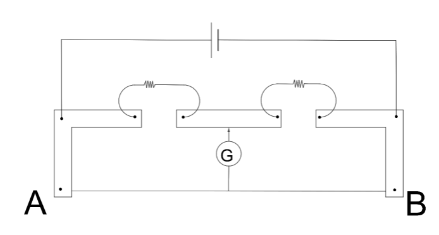Question
Question: A meter bridge set up as shown to determine end correction at \(A\) and \(B\). When a resistance of ...
A meter bridge set up as shown to determine end correction at A and B. When a resistance of 15 Ω is used in left gap and of 20 Ω in right gap, then null point comes at a distance 42 cm from A. When these resistance are interchanged, the null point comes at a distance 57 cm from A.Values of end correction are:

A. 1 cm, 2 cm
B. 2 cm, 3 cm
C. 3 cm, 4 cm
D. 3 cm, 2 cm
Solution
Firstly, we will use the idea of Wheatstone bridge principle. Then, we will take into consideration our concept of end correction. Finally, we will form equations for end corrections in each case and then solve the equations and evaluate the required answers.
Formula Used:
SR =100 − L +βL + α
Complete step by step answer:
The null point of a meter bridge is the point on the wire where the ratio of resistances connected in the gap becomes proportional to the ratio of the lengths of the pin of the meter bridge from either side of the bridge. When this happens, there is no current flowing through the galvanometer and thus the name null point. For the first case, we have
R = 15 Ω
⇒S = 20 Ω
⇒L = 42 cm
Thus, putting these values in the formula for the Wheatstone bridge, we get
2015 = 58 + β42 + α
Cross multiplying, we get
15 (58 + β) = 20 (42 + α)
Then, the equation turns out to be
870 + 15β = 840 + 20α
Thus, we have the equation as
20α − 15β = 30 −−−−−−−−−−−−− (i)
Now, for the second case,
R = 20 Ω
⇒S = 15 Ω
⇒L = 57 cm
Thus, putting in the values in the formula for Wheatstone bridge, we get
1520 = 43 + β57 + α
Further, we get
20 (43 + β) = 15 (57 + α)
Then, we get
860 + 20β = 855 + 15α
Further, we get
15α − 20β = 5 −−−−−−−−−−−−−−−−−−− (ii)
Now, evaluating 3 × (i) − 4 × (ii), we get
60α − 45β − 60α + 80β = 90 − 20
Thus, we get
35β = 70
Evaluating further, we get
β = 2
Substituting these values in equation (i), we get
20α − 15 × 2 = 30
Further, we get
20α − 30 = 30
Then, we have
20α = 60
Thus, we get
∴α = 3
Hence, the end corrections are 2 cm, 3 cm.
Thus, the correct option is B.
Note: Students often commit errors while solving the equations as they select a method where they fall into some clumsy calculations leading them eventually to the wrong answer. Students should keep in mind that the end correction is a necessary parameter in getting accurate and precise observations keeping the practical side of the meter bridge.
